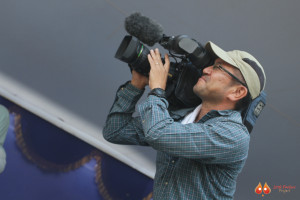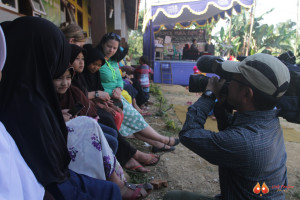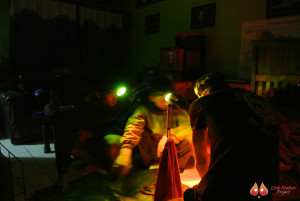Our work this month had a very different spin on it. For the last three weeks, we have been working with a film crew from the Japanese television network, NHK. Their plan is to make a documentary about the slow lorises for broadcast in Japan. As there have been many lorises documented as pets in Japan, extending our conservation message to the Japanese people could potentially have enormous benefits for all species of loris.

Our normal research activities had to take a backseat while we searched for the most interesting loris stories to film, and yet our workload was doubled. This was my first experience working with a film crew and it was a real challenge to make the process work. The film crew consisted of only three members, a camera man (Shima), a producer/lighting director (Mikio, whom we have named Maya’s baby after!), and a translator/coordinator (Tamiko).
What I was most surprised about is that when a film crew arrives at a site, they already have a story in mind and it’s the job of local researchers and local experts to try to make that happen. As you might imagine, wild animals do not always play by the rules or follow a storyline. As a result, more often than not, the story devised for a nature documentary will be very different from the original plan. I was also amazed by how non-invasive they have been in their work. Before the film crew arrived, I feared that they would either disturb the lorises with their bright lights or not be able to see in the dim red light that we use to observe them. Thankfully, they had a high-tech solution. Their ultra-high sensitivity camera allowed them to capture high definition videos while operating in red light even
lower than the red light that we use for observations. It’s an amazing piece of kit.

The NHK crew have had as much luck as they have had misfortune so far. Some of the lorises, in typical loris fashion, decided to hide in bamboo all night. Other nights, the lorises did plenty of travelling and exhibited foraging and feeding behaviour (including one of our female lorises, Lucu, eating some fruit which is not something we often see). These kinds of natural behaviours are great to see at times like this because it means that the film crew are not heavily disturbing the lorises in their nightly routine. Their success has been largely due to the efforts our trackers (Aconk, Adin, Dendi, and Yiyi) who expertly found all of the lorises the film crew wanted to capture on camera.
The film crew filled the role of researchers themselves one night when they became the first to discover that one of our female lorises, Sibau, had given birth to a new baby. Sibau only had a baby earlier this year so this is very interesting news indeed. Babies in our research area are always exciting as it is a sign that the lorises are still healthy and reproducing. Just last week, we collared an adult male in Sibau’s home range. This loris is more than likely the baby’s father. This may allow us to observe how the new arrival affects his behaviour. The timing couldn’t be better.

In a strange turn of events, the film crew also became a rescue team. This morning, they left for Cikananga Rescue Center to film some rescue lorises with some precious cargo on board. Last night the LFP team were presented with a young female loris found in an electricity box in the center of Garut, the nearest city to our field site. As the rescue center is roughly an eight hour drive away, it is difficult for us to transport lorises from our field site. Luckily the film crew’s trip to Cikananga was perfectly timed with our rescue, so they took on the job of transporting our city-dwelling, electricity-loving loris (Listrika, named for the Indonesia word for ‘electricity’: listrik).
The last television documentary made about the lorises here (Jungle Gremlins of Java) was back in 2012 by the BBC. The attention that it brought to the plight of the loris was truly amazing. The LFP team cannot wait to see how all the footage comes together and what impact this new documentary will have on the illegal trade in slow loris pets in Japan and elsewhere.
– Robert O’Hagan, LFP Research Coordinator
